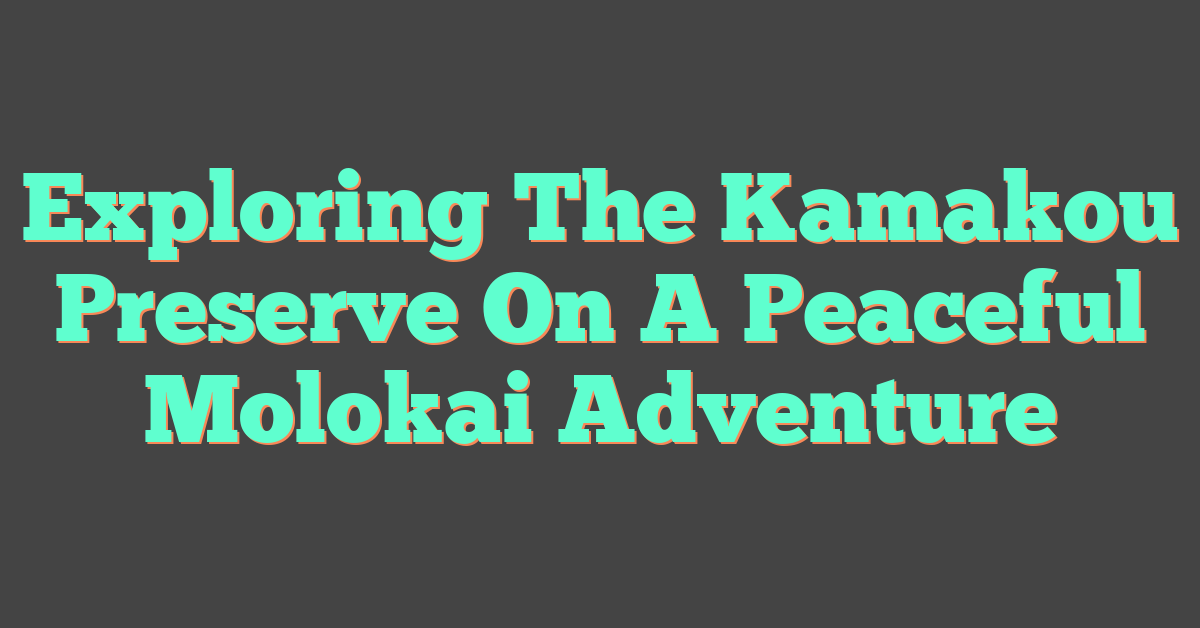High in the mountains of Molokaʻi, Kamakou Preserve invites you into one of Hawaiʻi’s most untouched rainforests. The preserve covers 2,774 acres on the slopes of the island’s tallest peak and shelters over 200 native plant species, many unique to this area.

Kamakou Preserve offers an ideal place to experience Molokaʻi’s natural beauty and learn about its special ecosystem.

You can follow the narrow Pēpēʻōpae boardwalk, a three-mile round-trip trail winding through lush forest and misty mountain views. The Nature Conservancy often leads guided hikes from April to October, sharing insights about rare plants, birds, and the preserve’s role in Molokaʻi’s water supply.
From its rich biodiversity to sweeping vistas, Kamakou Preserve reveals a side of Hawaiʻi far from crowded beaches and busy towns. The preserve lets you explore and learn in a peaceful, wild setting.
What Makes Kamakou Preserve Unique
Kamakou Preserve on Molokai contains one of Hawaii’s most intact native rainforests. The area supports rare plants and birds, protects a vital water source for the island, and preserves important cultural connections to the land.
Location and Setting
Kamakou Preserve sits high in the mountains of East Molokai. It covers about 2,774 acres on the slopes of Kamakou, the island’s tallest peak.
The elevation and remote location create a cool, misty climate year-round. The preserve is part of the Kawela watershed, which supplies about 7 million gallons of fresh water daily to Molokai residents.
This makes Kamakou a critical resource for the community. Access is limited to protect the land.
Most visitors reach it by a rugged 4WD road that leads to the Pepeʻopae Boardwalk Trail. The narrow path allows people to explore without harming the fragile environment.
Rainforest Habitat and Ecosystem
Kamakou Preserve hosts more than 250 native Hawaiian plant species, including mosses, ferns, and flowering shrubs. Many of these plants grow only here.
Birds like the ‘Apapane and ‘Amakihi feed on nectar from native blossoms. Insects and other small wildlife thrive in the dense vegetation.
The Nature Conservancy manages the area, controlling invasive species and protecting native habitats. Clouds often shroud the rainforest, and frequent rainfall keeps the ground damp.
Thick moss and lichen cover much of the forest. Boardwalks help prevent soil erosion and allow visitors to see the forest up close.
History and Cultural Significance
For Native Hawaiians, Kamakou holds deep cultural meaning. The mountain and forest appear in traditional stories and practices.
People have used plants from this area for medicine, tools, and ceremonies for generations. Over the past 30 years, The Nature Conservancy and local partners restored native vegetation and removed invasive plants.
Protecting Kamakou helps safeguard cultural heritage. The land remains a living connection between Molokai’s people, their history, and the island’s natural environment.
Flora and Fauna of Kamakou Preserve
Kamakou Preserve on Molokaʻi supports many species found nowhere else. Its rainforest, bogs, and mountain slopes provide the right conditions for rare plants and native birds, including some that are endangered.
Rare Hawaiian Plants
More than 250 native Hawaiian plant species grow in the preserve, with many unique to Molokaʻi. You can find ʻōhiʻa lehua trees with red or yellow blossoms and large hāpuʻu tree ferns along shaded trails.
The Pepeopae Bog shelters low-growing shrubs, mosses, and tiny flowering plants adapted to wet, nutrient-poor soil. Some plants are so specialized that they only survive here.
Walking the 3-mile boardwalk, you’ll see a mix of tall canopy trees and delicate understory plants. Native lobelias, sedges, and rare mint species add to the biodiversity.
Many plants help prevent erosion and support the watershed that supplies fresh water to the island.
Native Birds and Wildlife
The preserve gives Hawaiian forest birds a safe home, especially those that have lost habitat elsewhere. The ʻapapane, a small red honeycreeper, feeds on nectar from ʻōhiʻa lehua blossoms.
You can often hear its song above the rustle of leaves. Other native birds include the amakihi and iʻiwi, both important pollinators for native plants.
These birds help keep the forest healthy by spreading pollen and seeds. Insects, snails, and other small creatures also inhabit the area.
You might spot native damselflies near streams or see Hawaiian tree snails on leaves in the damp forest. Each species has adapted to the preserve’s unique climate and vegetation.
Endangered and Unique Species
Several species in Kamakou Preserve are endangered, including the kawawahie and olomao, forest birds now rarely seen. These birds once lived across Hawaii but now survive only in remote areas like this.
Some plants in the preserve are critically endangered because of habitat loss and invasive species. Conservation teams focus on removing invasive plants and protecting rare native seedlings.
The preserve’s isolation and limited access help protect these species. Only 4WD vehicles can reach the area, which reduces disturbance and keeps the ecosystem healthy.
Exploring the Trails and Scenic Spots

You can walk through a rainforest on a raised path, enjoy a mountain picnic spot with valley views, and take in one of Molokaʻi’s most striking overlooks. Each spot offers a unique way to see the island’s plants, birds, and landscapes.
Boardwalk Trail Experience
The Pepeʻopae Boardwalk Trail stretches about three miles through Kamakou Preserve’s cloud forest. Wooden planks keep hikers above the soft, wet ground and protect fragile vegetation.
The narrow trail means visitors usually walk single file. This helps prevent damage to the moss, ferns, and rare plants along the route.
Over 250 native Hawaiian plant species grow in the area, including some found nowhere else. Birdwatchers may spot native species like the ‘Apapane and ‘Amakihi.
The boardwalk can be slippery after rain, so sturdy shoes are important. The calm pace and even surface make it a good choice for a steady, scenic walk without steep climbs.
You can find more details about the boardwalk route and its purpose from Only In Hawaii.
Waikolu Lookout and Picnic Area
The Waikolu Lookout offers a wide view over Waikolu Valley, with steep green cliffs and deep valleys stretching toward the ocean. On clear days, you can see the layered ridges and watch the light change the colors of the slopes.
A small picnic area near the lookout gives you a place to rest and eat. Simple tables make it easy to unpack food while enjoying the view.
A cool breeze is common, so bring a light jacket for comfort. This spot is accessible by a 4×4 road, which can be rough in wet weather.
Drivers should plan for slow travel and be ready for narrow turns. The lookout makes a good mid-day stop before exploring other parts of the preserve.
Pelekunu Valley and Overlook
The Pelekunu Valley Overlook sits at the end of the boardwalk trail. From here, you can see one of Hawaii’s most remote valleys, framed by tall cliffs.
On clear days, the Pacific Ocean is visible beyond the valley floor. The overlook has no railings, so visitors should stay back from the edge.
The view is especially striking in the morning before clouds gather. Early arrivals often enjoy better visibility and fewer people.
This valley is part of a protected area and has no public road access. The overlook is the only way most people can see it, making the hike a highlight for many.
For directions to the trailhead, Lonely Planet provides clear guidance.
Visiting Kamakou Preserve Responsibly

You can enjoy Molokaʻi’s Kamakou Preserve while helping protect its rare plants, wildlife, and rainforest. Visiting this remote area requires planning, and respecting both the land and the local community is important.
How to Get There and Access
The road to Kamakou Preserve starts near Homelani Cemetery and climbs toward the island’s highest peak. It is a narrow, rough, one-lane dirt road with steep drop-offs.
A four-wheel drive vehicle is strongly recommended. Drivers use pullouts to let oncoming cars pass.
Wet conditions can make the route slippery, so check the weather before your trip. The preserve is not accessible by public transportation.
Cell service is limited, so bring a paper map or download offline directions. Parking is limited near the trailhead, so avoid blocking gates or driveways.
If you are not confident driving the road, consider joining a guided trip instead.
Guided Tours and Visitor Tips
The Nature Conservancy offers monthly guided hikes on the Pepeʻopae Boardwalk Trail, about 3 miles round trip. Guides help visitors learn about native plants, birds, and the area’s history.
Guided trips reduce the risk of damaging sensitive habitats. Leaders share safety tips, explain trail etiquette, and point out rare species along the way.
Wear long pants and covered shoes with good traction. Bring rain gear, as the weather can change quickly at higher elevations.
Pack water, snacks, and sunscreen. There are no restrooms or trash bins, so pack out everything you bring in, including food wrappers, bottles, and toilet paper.
Conservation Efforts and Community Involvement
The Nature Conservancy manages Kamakou Preserve as part of the East Molokaʻi Watershed.
This 2,774-acre area protects over 250 species of Hawaiian plants. Some of these plants grow only here.
Local groups control invasive species, maintain the boardwalk, and monitor native bird populations.
Volunteers help with trail maintenance and restore habitats.
Visitors support these efforts by following Leave No Trace practices and respecting posted guidelines.
Donations and participation in community workdays also fund preservation projects.




